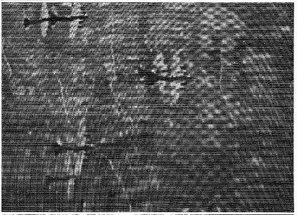|
I’m going to start out this post by writing about the work of the artist Christiane Baumgartner. Baumgartner is a visual artist, and the medium that she works in is woodcutting. Woodcutting is a long, taxing process that requires a great deal of cumbersome equipment, and each woodcut requires hours of work. In this age of mass reproduction, it’s an anachronistic medium--actually, it’s one of the oldest ways that images have been reproduced. Baumgartner doesn’t always work with ancient methods. While she learned the art of woodcutting first, she then broke into the field of digital video art. Following that, it seemed a natural progression for her as an artist to explore combining the two mediums. This is where things get particularly interesting. It seems so simple, but this act of combining this extremely modern medium, video, whose rewards are immediate and ubiquitous, with this old, laborious process whose rewards are painstakingly slow is so effective. In her woodcuts, she recreates digital stills, which she does by making many lines of varying thickness. This is a very simple way to represent very complex images. She often captures the images by filming a playing video, which creates a digital interference, which she is able to recreate in her woodcuts. In this way, her very medium is infused with meaning, and the statements her pieces make is heavily enforced by the process by which they were created. This efficacy is evident in viewing these images over the Internet, but in seeing them in person, these large woodcuts are pretty astounding. I won't bother going into an exhaustive analysis of her work, breaking down the intricate double codings taking place, but I hope you look into exploring more of her work. (A good interview with Baumgartner can be found here.) And from that discussion of a really great artist, I'd like to transition to talking about my own work. Hm. Well, here goes... In our piece exit crafting, Anna Weisling, Eric Sheffield and I hoped to create a piece that conveyed an effective experience to the audience. The process we used to develop the piece was one of performative collaboration--starting from some snippets of musical material I'd developed, we three sat down together and honed the segments of the piece into something that felt right, by playing through things together, giving each other feedback, and developing our own parts. Here's a video of us performing for a class at UW-Whitewater in December: The presentation of this piece is similar to that of much contemporary classical music. We premiered the piece at the Electroacoustic Juke Joint in Alabama in November. There was a lot of great music at that festival, but our piece stood out because of the process by which it was created. This is the connection I want to make with Baumgartner's woodcuts--that the process hopefully infuses the work with another layer of efficacy. I don't think that this is an inexperiential, intellectual efficacy, I think that the event of the performance is notably affected by this process. We developed the piece together, and we perform it together--not to appease the composer, but for a collective contribution to the piece itself.
Here are my 'formal' notes on exit crafting: exit crafting collaborative performance by Ben Willis, double bass Eric Sheffield, electronics, guitar Anna Weisling, visualizations The process for creating exit crafting was/is a collaborative one. That is, each member of the ensemble is responsible for their own part, and, in composition, responsible for effectively reacting to and critiquing the other parts of the ensemble. To those of us musicians who have been involved in musical groups within ‘popular’ idioms, such as rock bands, and, to an extent, jazz combos, this process doesn’t sound unfamiliar in the least. But in the world of Western Classical music, which is instilled with a separation of composers and performers--the idea that there is one composer, and the ensemble has only the creative liberty to interpret the piece--this process is rarely seen. The compositional language of exit crafting is intentionally located in a space between ‘art music’ and ‘popular music.’ The harmonies created are largely consonant, often based around fourths, fifths, triadic and tonal-sounding material. Formally, each section works through a series of changes--the first a gradual evolution of the pitches ascending in the bass, the second a series of sections that treat similar material in several ways (a repeated arpeggiating guitar pattern with melodic bass sounds layered on top), and the third a sort of merging of the two: sections that are different and moved through gradually elaborated material, but based in a distended pop-song form of verse-chorus-bridge, but is stretched in a way that disallows the sections from being repeated. The video element of exit crafting ties the material into a combined sensory experience. The video material was developed alongside the musical material, rather than sculpting one to fit the other, as when music is written for films, or music videos are made to complement pre-existing music. Comments are closed.
|
Authorbassist/improviser/ I send emails occasionally about upcoming performances. They're very cordial.
FriendsAnna Weisling
Anna Vogelzang Brothers Grimm Dave Wells Derek Worthington Dylan Chmura-Moore Eric Sheffield el-tin fun Jeff Herriott Jerry Hui Jonathan Kuuskoski Kirsten Carey Luke Polipnick mine, all mine! records New Muse Patrick Breiner Peter Mackie Pushmi-Pullyu Surrounded by Reality Tom Teslik Thistle Categories
All
Archives
February 2017
|


 RSS Feed
RSS Feed
